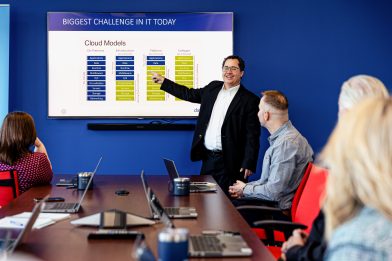The solution
As a technology solution provider with a broad range of expertise, Data Networks was well positioned to serve NFLC’s needs. To ensure the best long-term solution for the Center, Data Networks’ consulting team first huddled with NFLC IT staff for a road mapping session. It was during this road mapping session that Data Networks consultants targeted the replacement of NFLC’s legacy Citrix technology and simultaneous implementation of state-of-the-art virtual desktop infrastructure as a likely solution.
“At Data Networks, we’re attentive not only to our clients’ short-term improvement needs, but also to a long-term vision. Our road mapping sessions let us develop a three-year plan in collaboration with our clients to positively transform their IT infrastructure,” said Josh Pingel, Data Networks Solution Architect for End User Computing.
When it comes to VDI, Data Networks offers several advantages over competing solution providers. Data Networks solution architects and engineers possess the breadth and depth of virtualization expertise required to produce a very high success rate for these types of projects. This is especially true in the education industry. Another advantage: Data Networks’ high-level partnerships with world-class VDI hardware and software technology companies. For virtual environment hardware, Data Networks relied heavily on Dell components, selecting and installing Dell as the backbone of NFLC’s new infrastructure. Leveraging Dell’s Solution Configurator, Data Networks recommended and installed a Dell Compellent SAN (consisting of 500TB capacity, (8) 8GB Fibre Channel (FC) ports and (8) 1.9TB solid-state disks (SSDs)) along with three Dell PowerEdge R730 servers as the new VDI’s hardware layer.
The combination of the Compellent SAN and R730s represented tremendous value for NFLC. As a solution, it is enterprise-level VDI storage and provisioning hardware requiring only departmental-level physical space (occupying only a handful of rack space in NFLC’s available data center capacity) and cost. In addition, Compellent SANs and R730 servers both scale easily. Moreover, NFLC’s Compellent SAN would support the separation of high- and low-velocity data into tiers for effective caching purposes, and the R730s had the high data acceleration capability needed to sustain NFLC’s VDI and its entire virtual environment. Last but not least, because Dell hardware is generally open-standard in terms of connecting with switches and other network gear, NFLC could maintain their pre-existing FC switches and networking gear.
Next, Data Networks engineers installed software to support the new VDI. Again, the Dell hardware proved advantageous. VMWare virtualization management applications are “battle-tested” on Dell SANs and servers. Data Networks installed VMWare’s Horizon View series of VDI applications (Connection Server as the virtual server-VM communication platform, Composer for VM desktop pool administration/master image deployment updates through “linked clone” technology, and Security Server to enable secure connections between the data center and remote users in other security networks) for VM and user application access management. For NFLC IT staff administrators, Data Networks installed vRealize Operations for Horizon as a VDI architecture-wide monitoring and reporting solution.
After completing the VMWare software installation, Data Networks consultants finished by using NFLC’s existing “master” desktop image to create a new desktop image template. They then provisioned this image template to all 40 end users and led a series of VDI desktop management and application distribution testing with NFLC. A few issues arose. However, according to Pingel, “Data Networks doesn’t merely resell leading virtual technology from Dell and VMWare – we have relationships with them.” So, when NFLC’s Horizon Security Server initially couldn’t make successful connections from the data center to remote user desktops, Data Networks engineers worked together with VMware to easily get to the root cause of the problem and fix it permanently.
Mission accomplished
Since Data Networks’ completion of the VDI implementation, NFLC’s desktop and application virtualization technology performance and practices have improved substantially. NFLC subsequently requested from Data Networks an additional 100 Horizon View licenses in order to onboard additional groups of end users for whom virtualization had never been planned.
Says Nganga, “The consultation and hands-on assistance we’ve received from Data Networks in several areas, most notably in desktop and application virtualization, has been top-notch. We view them as an extension of the NFLC IT team and a conduit to trusted technology brands. Partners like Data Networks are very difficult to find.”







